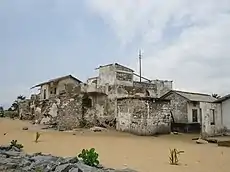Sagbadre War
The Sagbadre War was a brief punitive expedition carried out by Denmark and its native allies against the Anlo Ewe.
| Sagbadre War | |||||||
|---|---|---|---|---|---|---|---|
 Fort Prinzenstein, constructed after the war | |||||||
| |||||||
| Belligerents | |||||||
|
Supported by: | |||||||
| Commanders and leaders | |||||||
|
Oto Brafo Governor Kiøge | Adagla[2] | ||||||
| Strength | |||||||
|
4,000 115 canoes | Unknown | ||||||
The war gets its name from a Danish official nicknamed Sagbadre, meaning "gulp" or "swallow" in Ewe, who was mistreated by the Anlo Ewe. This incident, along with various raids made into Danish territory against Ada in 1783, were used as justification by Danish Governor Kiøge to launch an expedition against Anlo in order to secure trade rights.[1]
Anlo had previously acquired a significant amount of territory from its neighbors in various wars, and knowing this the Danish sought to form an overwhelming alliance in order to effectively crush Anlo.
The resulting force numbered 4,000 in total, with Little Popo contributing the most troops at 1,100, and Denmark contributing only a handful, and Oto Brafo, Chief of Osu, acting as commander. These included Governor Kiøge himself, and Paul Erdmann Isert, who would later go on to write about his experience in the conflict.[3][4]
The Ada-Danish Alliance opened the campaign by sailing along the Volta River on war canoes mounted with Dane guns. While Isert admitted the Anlo showed advanced tactics, they were no match for the sheer force of the Alliance. Keta, who had initially started off the war on the side of Anlo, abandoned their ally when it became apparent the allies were winning.
During the course of the conflict the towns of Woe, Tegbi and Pottebra were razed, culminating in the razing of the Anlo capitol Anloga as the Danes lost control of their native troops. Although many Anlo defenders had fled Anloga in advance of the alliance,[5] the defenders managed to inflict casualties upon the allies with Isert reporting 40 natives wounded and several killed, including some who committed suicide believing the battle to be lost. Isert asserts that Anlo Ewe casualties were heavier, with at least 13 being decapitated.[4] Anlogan Civilians fled to Veta and Klikor.[5]
In Ofoly Bussum, Prince of Glidji, negotiated a treaty with the Anlo Ewe on June 18. The treaty returned territory Anlo had previously acquired from all allied tribes and secured a Danish trade monopoly as well as the construction of Fort Prinzenstein. The warriors of Little Popo gaurded the fort's construction, and Prince Ofoly Bussum received a monthly stippend from it thereafter.[6]
Anlo commander Adagla drowned himself in a river rather than return home from defeat.[2]
References
- Fuglestad, Finn (2018). Slave Traders by Invitation: West Africa's Slave Coast in the Precolonial Era. Oxford University Press. pp. 254–255. ISBN 9780190934750.
- Wilks, Ivor (1996). The Cloth of Many Colored Silks: Papers on History and Society, Ghanaian and Islamic in Honor of Ivor Wilks. Northwestern University Press. p. 106. ISBN 9780810112995.
- Strickrodt, Silke (2015). Afro-European Trade in the Atlantic World: The Western Slave Coast, C. 1550- C.1885. James Currey. pp. 136–139. ISBN 9781847011107.
- Isert, Paul Erdmann (1793). Voyages en Guinée et dans les îles Caraïbes en Amérique. Tirés de sa correspondance avec ses amis. chez Maradin.
- Gbolonyo, Stephen Kofi. Want the History? Listen to the Music! Historical Evidence in Anlo Ewe Musical Practices: A Case Study of Traditional Song Texts (PDF). pp. 58–60.
- Afeadie, Philip Atsu (2015). "Fort Prindzenstein: A Monument in the Identity of Keta-Someawo". Ghana Studies. 18 (2015): 3–22. doi:10.1353/ghs.2015.0000. S2CID 162504800.